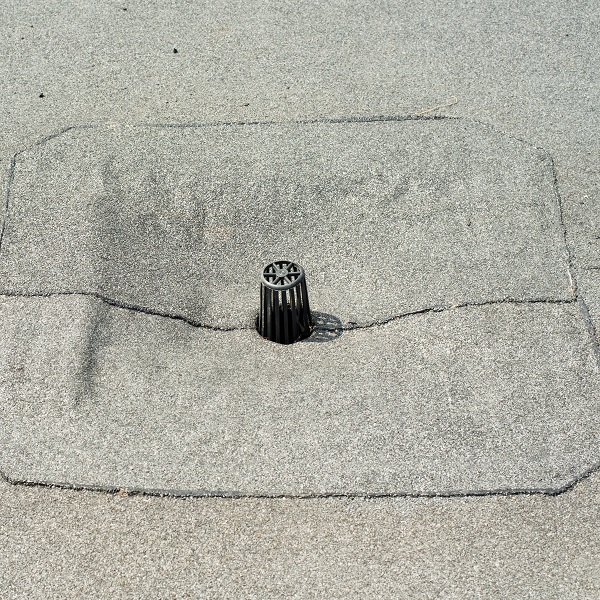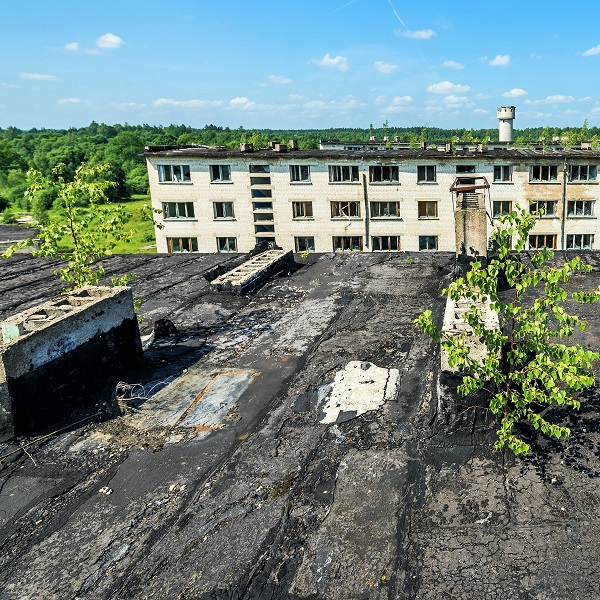Blog

Cleaned flat roof drain.

Old abandoned building with trees growing.
Roof maintenance: how to keep your roof in great shape
“Hello, Atlantic Roofers? Hi, there’s water coming in through the roof. I’m not sure how it’s getting in, but it’s running down a wall
This is not the kind of call you ever want to make. We get them occasionally, and most times the problem is entirely preventable. ‘An ounce of prevention is worth a pound of cure’ is a saying that’s especially true when it comes to roof maintenance.
Roof inspection and maintenance: safety first
All building owners should inspect their roofs, or have them inspected, every spring and fall. If you have access to a flat roof via a penthouse staircase or have other safe means of getting up on the roof, you can inspect and maintain your own roof.
If accessing the roof requires a ladder, if drains are close to the edge, or if there is is a lot of mechanical (HVAC units, etc.) on the roof, you will need
7 roof maintenance must-do’s
Clear the drains
This is tip #1 for a reason. Fall and winter bring lots of precipitation, while spring brings thaws and rain. For all that water to escape, your drains must be open and free of debris. Otherwise, come spring, you’re going to have a water problem, especially in Maritime Canada, with our heavy snowfalls. In the case of a commercial building, put markers—driveway markers work well—at the drains so that you can locate them in winter or early spring, should you need to shovel to keep them clear. Drains will typically do their job, despite snow and ice, if they are not clogged. Remove leaf litter, bird feathers and other debris from around screens and make sure that no significant debris has penetrated inside.
Batten down the hatches
Fall and winter are the seasons of wind storms. When you inspect your roof spring and fall, make sure that nothing is loose. Flapping metal and siding have a habit of tearing off in high winds, exposing walls and curbs to the elements, and creating airborne dangers. Make sure that all surfaces are intact, screwed down and properly sealed.
Remove sharp debris
A heavy accumulation of ice and snow can put pressure on the building structure, but it can also drive sharp debris into your roof membrane. Pick up any debris like screws and nails to avoid
Check your membrane
If your waterproof membrane is in good shape, you shouldn’t have any leakage. Be sure to spot check your membrane each time you inspect. Scuff away the gravel, pull up a few stones in a couple of spots and take a look. Is the membrane dried out, cracked or peeling? If the answer is yes, get a professional opinion.
Some building owners will wait until they have half a dozen leaks and mounting tenant complaints before they address roof membrane issues. Most often, it’s too late—the roof system is rotted out and in need of replacement. When it’s detected early, a professional roofing company can fix a leak quickly and inexpensively, then recover the roof. Some roof membrane manufacturers will let you renew your warranty at that point, and you will get another 15 years out of your roof, as well as the environmental benefit of less waste.
Recovering a roof costs about half of what you would pay to install a new roof—a savings of $3 to $6 per square foot. That’s a considerable amount, but more
Seal high, step high
Sometimes an extreme thaw event will cause snow to melt rapidly while drains are still covered in ice, causing water to
In the same vein, residential builders will quite often put the door sill out to the back deck almost at deck level. People don’t like to have to step down to the deck—they like to walk straight out. But if your deck is covered with snow and ice and water backs up against the building wall, there is
Relieve the pressure
Snow and ice can pose problems other than obstructing drains. One of our customers owns a mall. One February they called us to say that their moveable interior curtain-walls would not budge. They were correct in thinking that it was a roof problem—six feet of compacted, layered snow and ice on the roof was putting pressure on the structure, pushing it down enough that the curtain walls were tight against the floor. Once our crew shovelled the snow and ice off the roof, the problem resolved itself. In extreme situations, especially with older residential buildings, enough snow and ice will cave in a roof.
Upside down trees
Okay, it’s not the trees that are upside down! We’re talking about an Insulated Roof Membrane Assembly (an IRMA roof), something that roofers call an ‘upside down roof’. IRMA systems are commonly installed on commercial and larger residential buildings with flat roofs. There are several layers, with the waterproofing membrane at the bottom, next to the roof structure. Above that you have a moisture-resistant insulation layer to protect the membrane from solar degradation and weather in general, then a fine mesh layer that acts as a filter for debris. Over
Problems occur when dirt gets into the gravel. If you have trees around the building, seeds will take root and eventually you will have saplings growing on the roof. The roots will grow right through the insulation and eventually through the membrane, causing leaks. Keep the trees off your upside down roof—save them for a real green roof. Read our green roof blog.
Consider a roof maintenance plan
By rights, you should never experience a leak in your roof. Professional fall and spring inspections will identify risk factors before they turn into problems. If you do get a leak, call someone right away. If building insulation gets wet and
Atlantic Roofers offers roof maintenance plans for all types of buildings (Learn more about maintenance plans). These include twice yearly inspections, essential cleaning, and fastening of anything that has come loose. A roof maintenance plan is the best way to stay on top of roof issues (no pun intended) and ensure that you identify and remediate problem areas before they impact your building.
If you have
